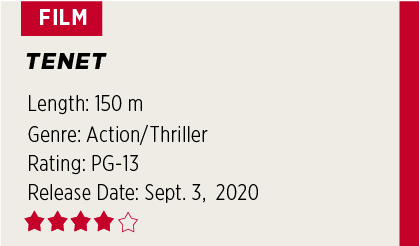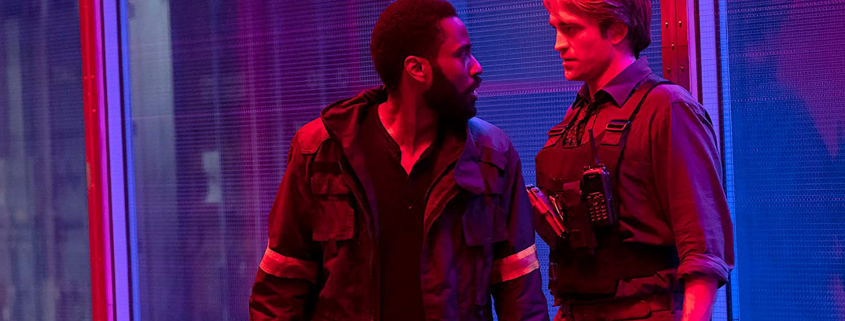REVIEW: ‘Tenet’ is an uneven yet gripping new action film from Christopher Nolan

Christopher Nolan is no stranger to making his audiences think, rather than feel. His new film “Tenet” is no exception to that philosophy. An exploration into the physics of time, the story itself requires an unavoidable suspension of disbelief. “Tenet” is full of dichotomies, making you feel conflicted by the end, yet still amazed by what Christopher Nolan has made.
The movie follows an unnamed spy known simply as The Protagonist (John David Washington). He’s an international operative who uses time-traveling technology called inversion to prevent World War III. Washington’s character arms himself only with a palindrome word, Tenet, to complete a mission that extends beyond real time.
The film itself also stretches past the casual running time for movies nowadays. Clocking in at a brisk 150 minutes, “Tenet” doesn’t just give a lot to its audience — it asks a lot as well. The movie is always one step ahead of its viewers, never allowing much time to breathe; that’s why it feels surprising when, suddenly, it’s all over.
“Don’t try to understand it. Feel it,” describes one of the characters, Barbara (Clémence Poésy), when explaining the science behind inversion to The Protagonist. At the same time, her dialogue expresses what Nolan wants from fans. If audiences cast away their overanalysis, then “Tenet” proves to be an enjoyable experience; if people instead speculate over the convoluted nature of the film’s plot and structure, then perhaps these viewers will find themselves tired, even frustrated by the film. Such is the case with the endings of many Nolan films back to Memento, but somehow “Tenet” takes the interpretive, deep finale to a whole new level.
Part of what makes “Tenet” confusing is the controversial sound design. Nolan has continued a trend from his previous films such as “Interstellar” and “Dunkirk” of mixing character dialogue well below music and sound effects, meaning that crucial information such as story context is sometimes inaudible.
However, this is just one of the many aspects of the film that serves two distinct purposes, as individual pieces of dialogue are meant to be cryptic and slightly indiscernible. Dualities like this will have a polarizing effect among audiences, but that’s partly what makes “Tenet” so bold. With complete creative control, Nolan made this film entirely on his own terms. “Tenet” is no easy introduction into Nolan’s style, and it’s not super accessible for the casual moviegoer, but because the film is so dense, it’s highly rewatchable, as every consecutive viewing may provide more information and a greater understanding.
On the topic of duplicities, “Tenet” finds Nolan working with some familiar faces, while simultaneously branching out to new collaborators. For instance, Nolan reunites with Hoyte Van Hoytema, who previously served as the cinematographer on “Interstellar” and “Dunkirk.” Therefore, the film looks flawless, including all its technical achievements of capturing certain characters and objects moving forward in time while others simultaneously run in reverse. Furthermore, his wife Emma Thomas, who has co-produced many of his films, continued as a producer for “Tenet.”
As for new partnerships, “Tenet” marks Nolan’s departure from his usual composer Hans Zimmer, as the German musician had signed onto Denis Villenueve’s upcoming film “Dune.” Thus, Nolan hired USC alumnus Ludwig Göransson, who has collaborated most frequently with fellow alumnus Ryan Coogler on films such as “Black Panther.” While the score may lack the signature motifs of Zimmer’s work, Göransson brings his own refreshing sound with an abrasive and hypnotically rhythmic score. Göransson even teamed up with rapper Travis Scott, who released a single for the film called “The Plan” leading up to the big release. The music certainly helps uplift the picture’s momentum.
Additionally, Nolan worked for the first time with Jennifer Lame, who is best known for her work as an editor on “Manchester by the Sea,” “Marriage Story” and “Hereditary.” At times the editing feels jumpy, almost jarring, but, for the most part, her editing effectively allows characters to travel beyond the traditional temporal design parameters.
“Tenet” is a bombastic movie, especially in terms of concept, ambition and worldbuilding. It almost feels like a two and a half hour trailer for another ten-hour movie; however, that’s one of the more intriguing parts about it, as every individual scene felt like a portal into another story, another universe. Trying to unravel the mystery of “Tenet” is part of the adventure.
As expected with Nolan films over the past decade, “Tenet” plays with time through a combination of gargantuan action sequences and witty expository dialogue. However, certain set pieces outshine others, and only time will tell which special effects moments will live up to the hype of other cinematic moments in Nolan’s filmography.
Maybe the glue that keeps all of Nolan’s moving parts together is the actors and their respective performances. John David Washington’s chemistry with Neil (Robert Pattinson) rivals the on-screen friendship of Leonardo DiCaprio and Joseph Gordon Levitt from “Inception.” The character, Kat (Elizabeth Debicki), also brought the most tension on-screen with the antagonist, Andrei Sator (Kenneth Branagh). Despite many new collaborators, Nolan delivers a familiar tone. The audience is not supposed to feel for the characters but rather the world that the characters embellish.
A major blockbuster hopeful to bring people back to the theaters, “Tenet” is only worth seeing if it can be done so safely. The movie is out wherever theaters have reopened, and no streaming services will have it for the foreseeable future.


